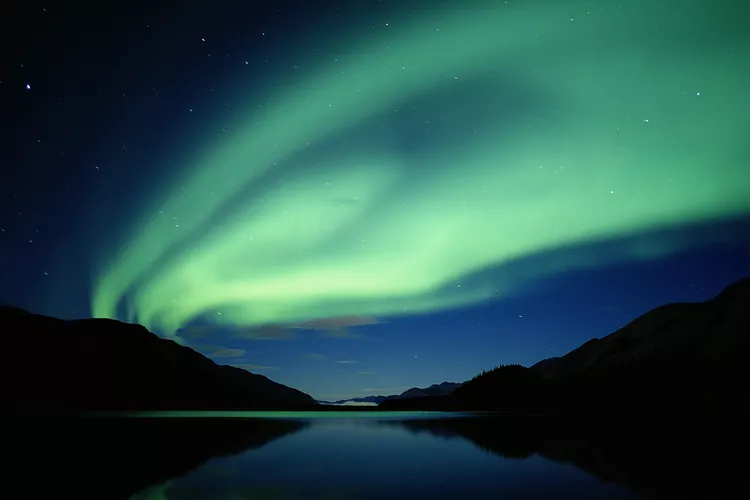Summary
No, they’re not all in Alaska.
For those seeking to explore every national park in the United States, visiting some of the northernmost parks in the country might provide an extra-special experience: seeing the northern lights. Also known as the aurora borealis, this atmospheric light show is created when charged particles from the sun impact the Earth’s magnetic field and fluoresce. Although the best viewpoints for the northern lights are generally around latitudes between 65 to 70 degrees north in a region called the auroral oval (which runs through northern destinations like Alaska, Canada, and Scandinavia), it is still possible to witness this stunning phenomenon well south of that range if conditions align perfectly. Specifically, there needs to be a combination of a strong geomagnetic storm and clear, dark skies. While seeing the aurora borealis is never guaranteed, here are seven U.S. national parks where you can potentially spot this elusive natural spectacle.
Denali National Park and Preserve, Alaska
:max_bytes(150000):strip_icc():format(webp)/denali-national-park-alaska_NPSLIGHTS0123-11ace3a0bf64426d87db434df83c7d1e.jpg)
With a remote northern location that experiences minimal light pollution, Denali National Park provides travelers with prime conditions for northern lights viewing. Spanning over six million acres between the national park and the preserve, getting around can be challenging. Only a 15-mile section of the park’s only paved road is open to private vehicles; thereafter, further exploration requires a bus or foot travel. Because Denali is situated so far north, the best time to visit is between August and April when nights are dark enough to enhance your chances of seeing the northern lights. Although you must prepare for frigid temperatures, those who brave the cold are often rewarded with mesmerizing displays of the aurora borealis.
Isle Royale National Park and Preserve, Michigan
:max_bytes(150000):strip_icc():format(webp)/isle-royale-national-park-michigan_NPSLIGHTS0123-e83a77d4662a49c9a83a60b38064bb8a.jpg)
Isle Royale, one of the least-visited national parks, is located on an island on Lake Superior just south of the Canadian border. This remote location makes the park an excellent spot for northern lights viewing due to minimal light pollution. However, the park is closed during winter when conditions are typically ideal for aurora sightings. Therefore, visitors can enjoy its beauty during fall or spring, which not only offers milder temperatures but also a chance to see more active northern lights, especially around the equinoxes in September and March.
Voyageurs National Park, Minnesota
:max_bytes(150000):strip_icc():format(webp)/voyageurs-national-park-minnesota_NPSLIGHTS0123-72d9f6fe11bb4cba9f12126584410b43.jpg)
Not far from Isle Royale is Voyageurs National Park, recognized as a dark-sky park by the International Dark-Sky Association. Unlike Isle Royale, it is open year-round and is much more accessible. Located on the border with Canada, its northern latitude enhances the chances to witness the northern lights during stronger solar events. Park officials recommend aiming for areas with the clearest views of the north, as the aurora typically manifests closer to the horizon rather than directly overhead. Prime viewing locations include the upper parking lot of Rainy Lake Visitor Center and the Meadowood Road Day Use Area.
Wrangell-St. Elias National Park and Preserve, Alaska
:max_bytes(150000):strip_icc():format(webp)/wrangell-st-elias-national-park-and-preserve-alaska_NPSLIGHTS0123-7dbba6190b844f3e8fa7728b2dea0cec.jpg)
Wrangell-St. Elias National Park and Preserve encompasses 13.2 million acres, making it larger than Switzerland. It features a wide elevation range, from sea level to the summit of Mt. St. Elias at 18,008 feet. Consequently, while it’s not easy to navigate, its remoteness paired with its geographical location near the auroral zone creates excellent opportunities to view the northern lights. The park has only two gravel roads that are technically open year-round, although winter conditions can make driving challenging. Those who prioritize safety and are willing to make the trek may get to witness spectacular aurora displays in this expansive wilderness.
Glacier National Park, Montana
:max_bytes(150000):strip_icc():format(webp)/glacier-national-park-montana_NPSLIGHTS0123-fc623431ab5f437bb7a63b9243c44ecd.jpg)
Located slightly farther north than other continental U.S. parks, Glacier National Park is a favorable option for witnessing northern lights, provided there is sufficiently strong geomagnetic activity. It is designated as an International Dark-Sky Park, significantly reducing light pollution. However, as with many southern parks, you may find the aurora appears closer to the horizon rather than overhead. Therefore, it is advisable to find an open area with views of the northern sky. Popular spots include Lake McDonald, Bowman Lake, and Kintla Lake, along with various overlooks along Looking Glass Road. For a cozy experience while viewing the aurora, consider visiting the Northern Lights Saloon in Polebridge.
Theodore Roosevelt National Park, North Dakota
:max_bytes(150000):strip_icc():format(webp)/theodore-roosevelt-national-park-north-dakota_NPSLIGHTS0123-50b10617ce264a8bba66c55596be3c51.jpg)
Covers over 70,000 acres of badlands in western North Dakota, Theodore Roosevelt National Park is positioned in the southern half of the state, making sightings of the northern lights less frequent. Viewing opportunities depend significantly on solar activity; however, when the conditions are right, you can enjoy expansive skies for a spectacular show. Moreover, the park’s remote nature and minimal light pollution provide excellent stargazing across clear nights, so even in the absence of auroras, watching the Milky Way or meteor showers can be equally rewarding.
Acadia National Park, Maine
:max_bytes(150000):strip_icc():format(webp)/acadia-national-park-maine_NPSLIGHTS0123-542561e76cb546b5a00a7e0a287f6fa6.jpg)
While Acadia National Park is relatively far south, sightings of the aurora are still possible, particularly during strong solar storms, creating the opportunity for spectacular displays. Acadia is notable for its accessibility, being just under three hours from Portland, Maine, and about five from Boston. Despite its proximity to urban areas, the park benefits from limited light pollution. Those aiming to catch the northern lights would do well to head to the higher elevations, such as Cadillac Summit, for the best views. However, be mindful that Cadillac Summit is closed during the winter and requires a reservation from spring to fall. As always, ensure you face north and scan along the horizon for the best chance to see the aurora.




